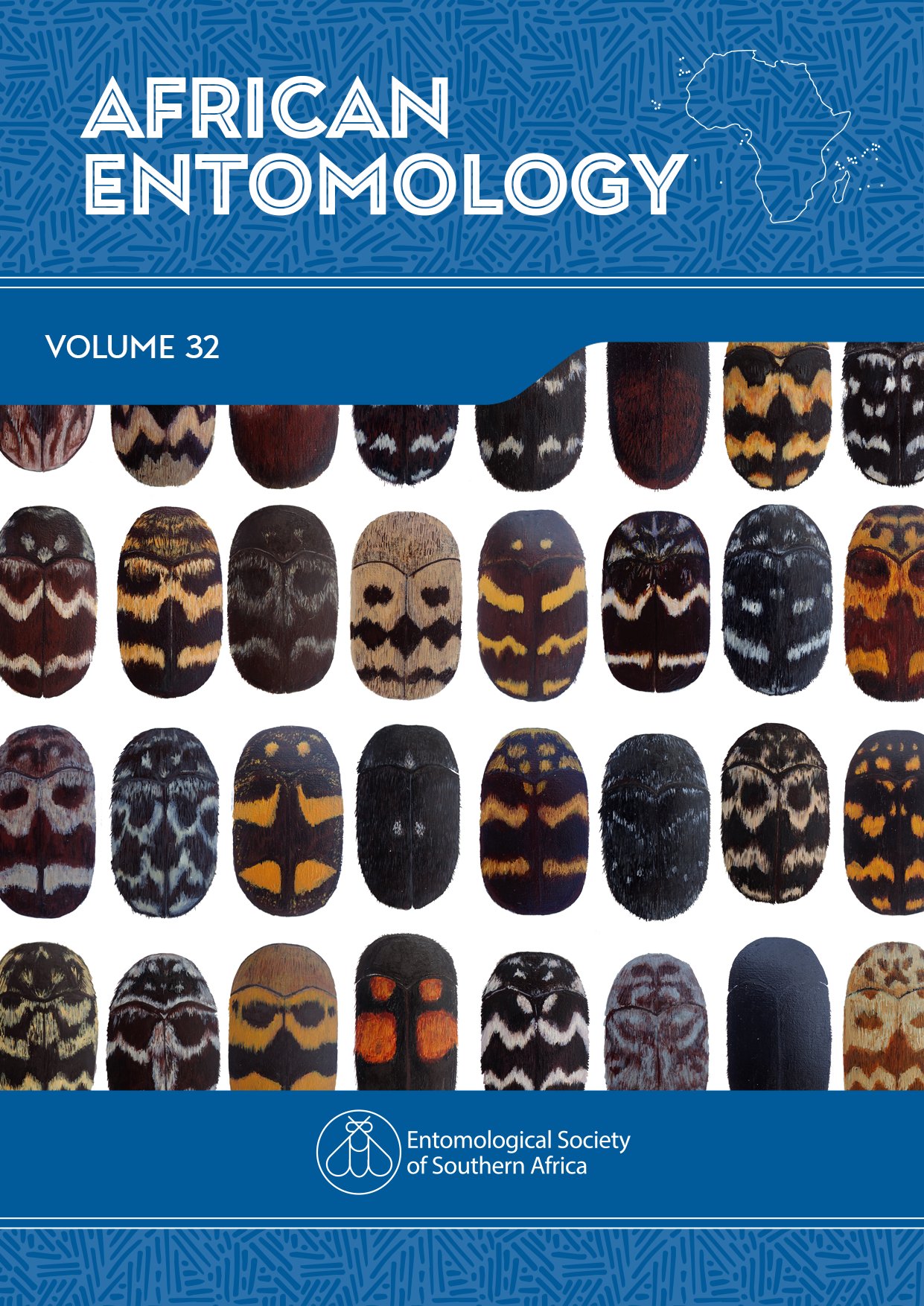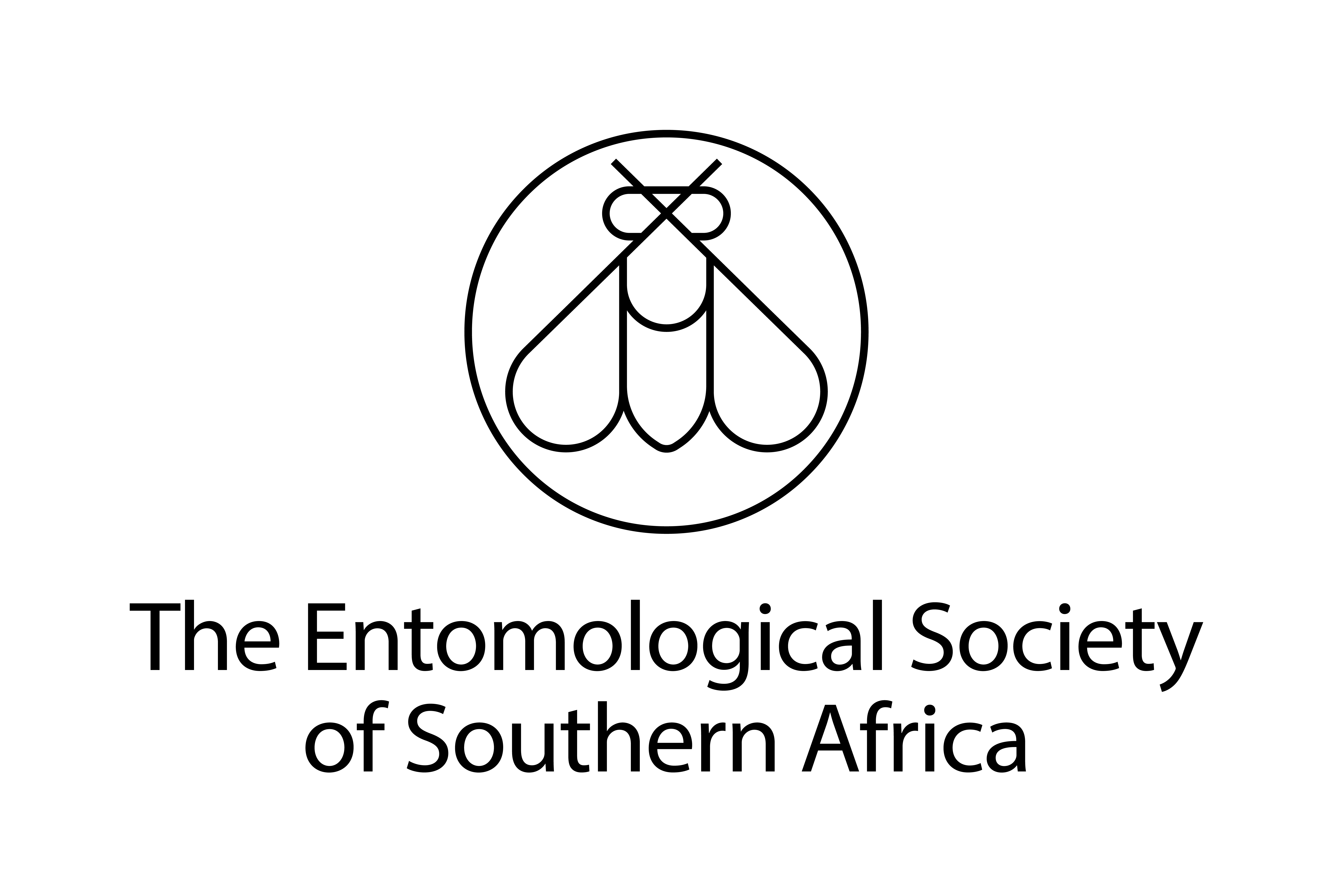An analysis of the phase status of the red locust, Nomadacris septemfasciata (Serville) in KwaZulu-Natal, South Africa
DOI:
https://doi.org/10.17159/2254-8854/2024/a19103Keywords:
Orthoptera, morphometrics, pest management, E/F ratios, sugarcaneAbstract
Nomadacris septemfasciata is a true locust species and exhibits phase polymorphism, which can potentially lead to outbreaks and plagues. In a recent outbreak of acridids in sugarcane in South Africa, swarms of N. septemfasciata were observed at increasing densities and displaying colouration indicative of the gregarious phase. The aim of this study was to determine the density-dependant phase polyphenism of populations of N. septemfasciata occurring in sugarcane study sites, based on traditional and geometric morphometric measurements, eye stripes and field observations of hopper colour specimens of N. septemfasciata were collected at three locations from May 2012 to May 2013. Three body characters (length measurements) were measured on 594 individuals and the number of dark vertical stripes on the eyes were counted. Lastly, 100 specimens from two locations (25 males and 25 females from each location) were analysed using geometric morphometrics, based on landmarks on wings. Significant differences in E/F ratios were found between locations and seasons, while wing shape also indicated a significant difference between locations (although small) and wing size (centroid size) showed no significant differences. There was a highly significant difference between wing shape of males and females, and the more gregarious males also exhibited higher E/F ratios in many instances. Eye stripes did not appear to be a reliable character and seemed to contradict the E/F ratio values. To our knowledge, this is the first report of using geometric morphometrics, traditional morphometrics and the number of eye stripes to assess phase polyphenism in adult locusts.
Downloads
References
Adams DC, Rohlf FJ, Slice, D.E. 2004. Geometric morphometrics: then years of progress following the ‘revolution’. Italian Journal of Zoology 71: 5–16. https://doi.org/10.1080/11250000409356545 DOI: https://doi.org/10.1080/11250000409356545
Albrecht FO. 1957. Phase and moulting polymorphism in locusts. Evolution 11: 166–177. DOI: https://doi.org/10.1111/j.1558-5646.1957.tb02886.x
Anonymous. 1936. The Fourth International Locust Conference, Cairo, 1936. (1938). Current Science 6(12): 585–588.
Bam AJ. 2014. Locust and Grasshopper Outbreaks in Zululand Sugarcane, KwaZulu-Natal, South Africa. Unpublished Master of Science Dissertation. Stellenbosch University, South Africa. https://scholar.sun.ac.za/home
Baylac M, Villemant C, Simbolotti G. 2003. Combining geometric morphometrics with pattern recognition for the investigation of species complexes. Biological Journal of the Linnean Society 80: 89–98. https://doi.org/10.1046/j.1095-8312.2003.00221.x DOI: https://doi.org/10.1046/j.1095-8312.2003.00221.x
Bazelet CS. 2011. Grasshopper Bioindicators of Effective Large Ecological Networks. Unpublished PhD Thesis University of Stellenbosch, Stellenbosch. https://scholar.sun.ac.za/home
Beasley DE, Bonisoli-Alquati A, Welch SM, Moller A, Mousseau TA. 2012. Effects of parental radiation exposure on developmental instability in grasshoppers. Evolutionary Biology 10: 1–14. https://doi.org/10.1111/j.1420-9101.2012.02502.x DOI: https://doi.org/10.1111/j.1420-9101.2012.02502.x
Blackith RE. 1960. A synthesis of multivariate techniques to distinguish patterns of growth in grasshoppers. Biometrics 16: 28–40. https://doi.org/10.2307/2527953 DOI: https://doi.org/10.2307/2527953
BouΪchi AS, Simpson SJ , Roessingh P. 1996. The influence of environmental microstructure on the behavioural phase state and distribution of the desert locust Schistocerca gregaria. Physiological Entomology 21: 247–256. https://doi.org/10.1111/j.1365-3032.1996.tb00862.x DOI: https://doi.org/10.1111/j.1365-3032.1996.tb00862.x
Brédo HJ. 1938. Phase de Nomadacris septemfasciata Serville au Congo Belge. C.R. Cinquiéme conference international pour les recherches antiacridiennes: Bruxelles. Royavmede Belqique ministére des colonies, Bruxelles. Report 46: 406–409.
Breuker CJ, Brakefield PM, Gibb, M. 2007. The association between wing morphology and dispersal is sex-specific in the Glanville fritillary butterfly Melitaea cinxia (Lepidoptera: Nymphalidae). European Journal of Entomology 104: 445–452. https://doi.org/10.14411/eje.2007.064 DOI: https://doi.org/10.14411/eje.2007.064
Burnett GF. 1951a. Observations on the life history of the red locust Nomadacris septemfasciata (Serville) in the solitary phase. Bulletin of Entomological Research 42: 473–490. DOI: https://doi.org/10.1017/S0007485300025475
Burnett GF. 1951b. Field Observations on the Behaviour of the Red Locust (Nomadacris septemfasciata Serville) in the Solitary Phase. Anti-Locust Bulletin 8: 1–37.
Camuff D, Enzi S. 1991. Locust invasions and climatic factors from the middleages to 1800. Theoretical and Applied Climatolog 43: 43–73. DOI: https://doi.org/10.1007/BF00865041
Carnegie AJM. 1982. Red locust swarm in Swaziland sugarcane fields. South African Sugar Journal. 66: 326.
Dryden IL, Mardia KV. 1998. Statistical shape analysis. John Wiley & Sons, New York.
Duranto, JF. 1997. Fléau acridien á Madagascar. Sécheresse 8(2): 138.
Faure JC. 1935. The life history of the red locust (Nomadacris septemfasciata (Serville)). Bulletin No. 144 Union Department of Agriculture, Pretoria, South Africa.
Franc A, Rabesisoa L, Luong-Skovmand MH, Lecoq M. 2005. Phase polymorphism in the red locust (Nomdacris septemfasciata Serville) (Orthoptera: Acrididae) in Madagascar. International Journal of Tropical Insect Science 25:182–189. https://doi.org/10.1079/IJT200572 DOI: https://doi.org/10.1079/IJT200572
Francoy TM, Silva RAO, Nunes-Silva P, Menezes C, Imperatriz-Fonesca VL. 2009. Gender identification of five genera of stingless bees (Apidae: Meliponini) based on wing morphology. Genetics and Molecular Research 8(1): 207–214. https://doi.org/10.4238/vol8-1gmr557 DOI: https://doi.org/10.4238/vol8-1gmr557
Golding FD. 1934. On the ecology of Acrididae near lake Chad. Bulletin of Entomological Research 25: 263–303. DOI: https://doi.org/10.1017/S0007485300012670
International Red Locust Control Service (IRLCS). 1937. The study of phases in locusts and grasshoppers. Proceedings of the 4th International Locust Conference, Cairo. pp 52–54.
Iversen GR, Norpoth H. 1976. Analysis of variance. Sage University Paper series on Quantitiative Applications in the Social Sciences, No. 07-001. Sage Publications, Beverly Hills, CA.
Klingenberg CP, McIntyre GS, Zaklan SD. 1998. Left-right asymmetry of fly wings and the evolution of body axes. Proceedings of the Royal Society of London 26: 1255–1259. https://doi.org/10.1098/rspb.1998.0427 DOI: https://doi.org/10.1098/rspb.1998.0427
Klingenberg CP, Debat V, Rohlf DA. 2010. Quantitative genetics of shape in cricket wings: developmental integration in a functional structure. Evolution 64: 2935–2951. https://doi.org/10.1111/j.1558-5646.2010.01030.x DOI: https://doi.org/10.1111/j.1558-5646.2010.01030.x
Klingenberg C. 2011. MORPHOJ: an integrated software package for geometric morphometrics. Molecular Ecological Resources 11: 353–357. https://doi.org/10.1111/j.1755-0998.2010.02924.x DOI: https://doi.org/10.1111/j.1755-0998.2010.02924.x
Lecoq M, Andriamaroahina TRZ, Solofonaina H, Gay PE. 2011a. Ecology and population dynamics of solitary Red Locusts in southern Madagascar. Journal of Orthoptera Research 20(2): 141–158. https://doi.org/10.1665/034.020.0202 DOI: https://doi.org/10.1665/034.020.0202
Lecoq M, Chamouine A, Luong-Skovmand MH. 2011b. Phase dependant colour polyphenism in field populations of red locust nymphs (Nomadacris septemfasciata Serv.) in Madagascar. Psyché Special issue on Locusts and Grasshoppers: Behaviour, Ecology, and Biogeography, 12 pages. https://doi.org/10.1155/2011/105352 DOI: https://doi.org/10.1155/2011/105352
Loher W. 1990. Pheromone and phase transformation in locusts. In Chapman RF, Joern A (Eds) Biology of grasshoppers. New York: John Wiley and Sons. 563 pp.
Lea A. 1935. The Red Locust in Natal. The South African Sugar Journal 19, 20: 41–52, 97–106.
Lea A, van Webb D. 1939. Field observations on the Red Locust at Lake Rukwa in 1936 and 1937. Science Bulletin, Union of South Africa Department of Agriculture and Forestry. 189: 1–84.
Mahalanobis PC, Majumdar DN, Rao CR. 1934. Anthopometric survey of the United Provinces. Sankhya 2: 98–360.
Michelmore APG. 1947. The habits and control of the Red Locust in outbreak areas and elsewhere. Bulletin of Entomological Research 37: 331–379. DOI: https://doi.org/10.1017/S0007485300030431
Michelmore APG, Allen W. 1934. Observations on phases of the red-winged locust in Northern Rhodesia. Bulletin of Entomological Research 25: 101–128. DOI: https://doi.org/10.1017/S0007485300012530
Petit D, Picaud F, Elghadraoui L. 2006. Gémétrie morphologique des Acrididae (Orthoptera: Caelifera); sexe, stridulation, caractére. Annales de la Société entomologique de France 42(1): 63–73. DOI: https://doi.org/10.1080/00379271.2006.10697450
Price RE. 2023. Invasions and local outbreaks of four species of plague locusts in South Africa: A historical review of oubreak dynamics and patterns. Insects 14: 846. https://doi.org/10.3390/insects14110846 DOI: https://doi.org/10.3390/insects14110846
Rainey RC, Waloff Z, Burnett GF. 1957. The Behaviour of the Red Locust (Nomadacris septemfasciata Serville) in Relation to the Topography, Meteorology and Vegetation of the Rukwa Rift Valley, Tanganyika. Anti-Locust Bulletin 26. Anti-locust Research Centre, London.
Rohlf F. 2008. TpsDIG, v. 2.12. NY, State University at Stony Brook.
Rohlf FJ, Slice D. 1990. Extensions of the Procrustes method for the optimal superimposition of landmarks. Systematic Zoology 39: 40–59. https://doi.org/10.2307/2992207 DOI: https://doi.org/10.2307/2992207
Simpson SJ, Sword GA. 2006. Phase polyphenism in locusts: mechanisms, population consequences, adaptive significance and evolution. In Whitman DW, Ananthakrishnan TN (eds.) Phenotypic plasticity of insects: mechanisms and consequences. Science Publishers. USA.
Sword GA, Lecoq M, Simpson SJ. 2010. Phase polyphenism and preventative locust management. Journal of Insect Physiology 56: 949–957. https://doi.org/10.1016/j.jinsphys.2010.05.005 DOI: https://doi.org/10.1016/j.jinsphys.2010.05.005
Têtefort JP, Winterbert D. 1967. Ecologie et comportement du Criquet nomade dans le Sud-Ouest Malgache. Annales de la Société Entomologique de France 3: 3–30.
Symmons P, Carnegie AJM. 1959. Some Factors Affecting Breeding and Oviposition of the Red Locust Nomadacris septemfasciata (Serville). Bulletin of Entomological Research 50: 333–355. DOI: https://doi.org/10.1017/S0007485300054614
Uvarov BP. 1921. A revision of the genus Locusta, L. (=Pachytylus, Fieb.) with a new theory as to the periodicity and migrations of locusts. Bulletin of entomological research 12: 135–163. https://doi.org/10.1017/S0007485300044989 DOI: https://doi.org/10.1017/S0007485300044989
Whellan JA. 1968. Locusts in relation to sugar cane. Proceedings of the South African Sugar Technologists’ Association: 1–5.
Downloads
Published
Issue
Section
License
Copyright (c) 2024 Adrian Bam, Des Conlong, Pia Addison

This work is licensed under a Creative Commons Attribution 4.0 International License.




.png)